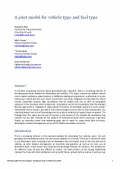-
Past ETC Papers

Browse, search and view papers from the past AET Conferences.
-
Members' Area

AET promotes networking and exchange of ideas, information and opportunities amongst members.
Conference Papers 2009
Noordwijkerhout, Netherlands
ETC Conference Papers 2009
A joint model for vehicle type and fuel type
Seminar
Day 1 (5 Oct 2009), Applied Methods in Transport Planning, Car Ownership, Alternative Fuels, 13:30 - 13:30
Status
Accepted, documents submitted
Authors
S Hess, ITS, University of Leeds, UK; M Fowler, T Adler, Resource Systems Group, Inc., US
Abstract
There is increasing interest in the potential demand for alternative fuel vehicles, given not only growing environmental concerns, but also the recent increases in the cost of fuel. A number of approaches for alternative fuels have been put forward, including using a mix between ethanol and traditional fuel, a greater reliance on natural gas, and various types of partially or fully electric vehicles. The preferences for different types of fuel are difficult to predict, not least because of the strong relationship between fuel type and other attributes such as performance, annual costs as well as incentives (e.g. tax breaks). At the same time, there is a very strong link between fuel type and vehicle type, with certain types of fuel only really being appropriate for specific vehicle types.
In this paper, we discuss work from the 2008-09 California Vehicle Survey (CVS), aimed at providing input data for the California (light-duty) Conventional and Alternative Fuel Response Simulator (CALCARS) model. CALCARS was developed to meet California legislation enacted in 1992, which requires the Energy Commission to analyze strategies for reducing petroleum dependency in California. To meet the objectives of CALCARS, the 2008-09 CVS collected both stated and revealed preference data for vehicle ownership and vehicle choice to forecast the penetration and use of both conventional and alternative fuel vehicles. The CVS will be the Energy Commission's primary updated source for light-duty vehicle choice and usage data.
In particular, we focus on the stated choice survey component of this work. This involved the design of a highly complex survey tool, which included seven fuel types, fifteen vehicle types, and up to eleven level-of-service attributes, such as cost, fuel consumption, fuel availability, refuelling time and acceleration. To reduce the survey complexity, each choice situation made use of only four alternatives, where this included a reference vehicle and three other vehicles assigned on the basis of a weighting approach. An internet-based survey was used to collect the data, enabling the collection of a very large sample.
The actual analysis of the data makes use of state-of-the-art modelling techniques. Specifically, we discuss the use of a mixed cross-nested logit model structure. In this approach, a cross-nesting structure was used to allow for the correlations jointly along the vehicle type and fuel type dimension, while the mixing was used to allow for the expected high degree of heterogeneity in respondents? preferences in this context.
Other than the obvious policy interest, this research has a number of important implications for future model development. First of all, we discuss the development of a highly complex survey with a very large number of attributes, and show how appropriate design techniques and presentation can make such complex choice scenarios accessible to respondents. Secondly, the research is innovative in that it looks jointly at the choice of vehicle type and fuel type, along with allowing for correlations along either dimension and permitting the representation of taste heterogeneity.
Documents:

Association For
European Transport
Forester House
Doctors Lane
Henley-in-Arden
Warwickshire, UK
B95 5AW
+44 (0) 15 64 793552
VAT number: 710 1866 64
Conference Supporters & Endorsers




Legal Entity
The Association for European Transport is registered as an Association ('vereniging') with the Chamber of Commerce for Haaglanden in The Netherlands under company number 27170096.
Built on Zenario




